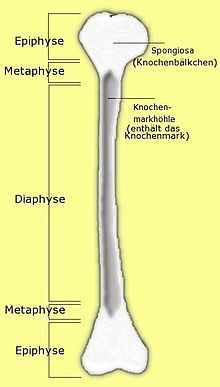Long bones
As long bone , a long bone or long bone ( Os longum , plural Ossa longa ) is known bone with a uniform medullary cavity in the bone marrow is. Long bones are found exclusively in the extremities. Here, the "long bones", let humerus ( humerus ), Elle ( ulna ) and spoke ( radius ), thigh bone ( femur ) and shin ( tibia ) and fibula ( fibula ) from the "short tubular bones", metacarpal and Differentiate between the metatarsal bones ( metacarpals or metatarsals ) and finger and toe bones ( Ossa digitorum manus or pedis , or simply phalanges ).
construction
The long bones consist of two bone ends ( epiphyses ) and a bone shaft ( diaphysis ). The short section in the transition from the epiphysis to the diaphysis is called the metaphysis .
The two epiphyses consist of a fine network of trabeculae, which are aligned according to the main directions of the acting forces ( trajectories ). These trabeculae together form a spongy bone substance ( substantia spongiosa ). Between the trabeculae are cavities ( cellulae medullares ) in which red bone marrow is located. On the outside, the substantia spongiosa is covered by a thin layer of compact bone substance ( substantia compacta ). A layer of hyaline cartilage ( cartilago articularis ) sits on top of it in the area of the joint surfaces .
In addition, there are often other bone attachments; which arise from the epiphyses, such as the greater trochanter on the thigh bone or the greater tuberosity of the humerus , which are called the apophysis and have their own growth plate , the apophyseal plate.
In the diaphysis, however , the trabecular structure has almost completely receded and inside there is a uniform medullary cavity ( Cavitas medullaris ) with yellow bone marrow (fat marrow). The mechanical strength of the diaphysis is therefore due to the compact bone substance ( substantia compacta or substantia corticalis ), which surrounds the medullary canal like a sleeve.
The epiphyseal plate (growth plate) is located between the respective epiphysis and the diaphysis in growing individuals . It consists of hyaline cartilage and is used to increase the length of a long bone. After the end of growth, this epiphyseal plate ossifies and often remains visible as an epiphyseal line ( linea epiphysealis ) into old age.
Except at the articular cartilage surfaces of the whole bone of which is bone skin (periosteum) covered.
An artery passes through the diaphysis to supply blood to the bone. The opening at which the blood vessel passes through the bone mantle is known as the foramen nutricium , and the artery as the arteria nutricia . The epiphyses usually have their own blood supply arteries ( Arteriae epiphyseales ), which are independent of the arteria nutricia of the diaphysis.
See also
literature
- Gerhard Aumüller, Gabriela Aust, Andreas Doll, Jürgen Engele, Joachim Kirsch, Siegfried Mense, Dieter Reissig, Jürgen Salvetter, Wolfgang Schmidt, Frank Schmitz, Erik Schulte, Katharina Spanel-Borowski, Werner Wolff, Laurenz J. Wurzinger, Hans-Gerhard Zilch : Dual series: anatomy. 2nd edition, Thieme-Verlag, Stuttgart 2010, ISBN 978-3-13-136042-7 , pp. 185 f.
- F.-V. Salomon: Bony skeleton. Pp. 37-110 in: Salomon, F.-V. ua (Hrsg.): Anatomie für die Tiermedizin. 2nd ext. Edition, Enke-Verlag, Stuttgart 2008, ISBN 978-3-8304-1075-1
